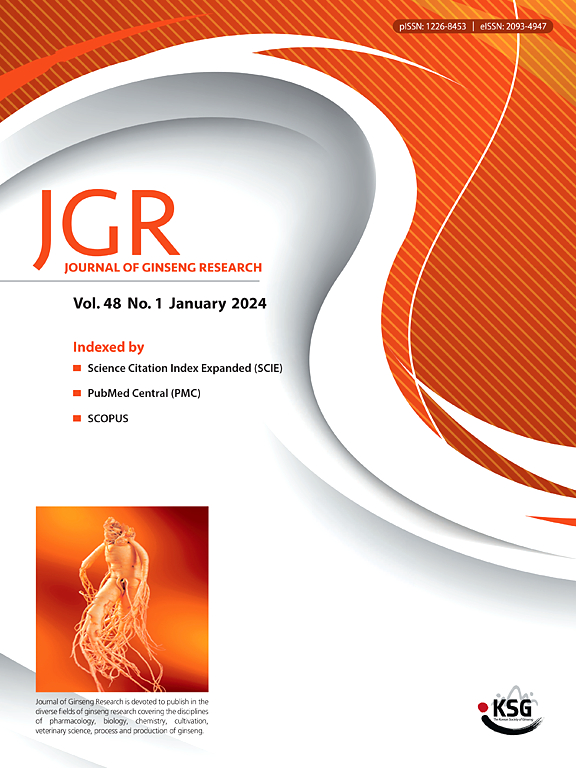Identification of AIF1 as a protein target of notoginsenosides in brain tissue of mice with intracerebral hemorrhage based on hapten immunoaffinity fishing technique
IF 6.8
2区 医学
Q1 CHEMISTRY, MEDICINAL
引用次数: 0
Abstract
Background
Intracerebral hemorrhage (ICH) is a deadly stroke with high mortality or disability. Although recent research has demonstrated the efficacy of Panax notoginseng in ICH therapy, it is unclear which proteins may be targeted to achieve these advantages.
Methods
First, we generated polyclonal antibodies against notoginsenosides by immunizing rats with a ginsenoside Rh1-mcKLH conjugate. Second, the potential target proteins of notoginsenosides in brain tissue of ICH mice were identified using LC-MS-based hapten immunoaffinity fishing (HIAF). Third, the disease target databases and these proteins intersected. Fourth, biolayer interferometry (BLI), molecular docking, and site-directed mutagenesis were performed to validate allograft inflammatory factor 1 (AIF1) as a protein target of notoginsenosides. Last, bioinformatics analysis was performed to examine AIF1's biological characteristics.
Results
A potential protein target of notoginsenosides, AIF1, was found by intersecting the identified protein targets with the disease target databases via LC-MS-based HIAF. BLI analysis revealed that Compound K (CK) and AIF1 had the highest direct interaction, with an average shift value of 0.1091 nm. Subsequently, site-directed mutagenesis, molecular docking, and BLI kinetic analysis demonstrated that CK specifically bound to AIF1 with an affinity value of 4.33 ± 0.17E-6 M, with a significant reliance on residues L122 and E125. Bioinformatics analysis showed that AIF1 and its directly interacting proteins were associated with microglial activation.
Conclusion
Our study proposed a new technology for screening natural small molecule protein targets, and successfully identified AIF1 as a protein target of notoginsenosides, providing a chemical and biological basis for further research into targeting AIF1 to treat ICH.

基于半抗原免疫亲和捕捞技术的脑出血小鼠脑组织中三七皂苷蛋白靶点AIF1的鉴定
脑出血(ICH)是一种死亡率和致残率高的致死性中风。虽然最近的研究已经证明了三七在脑出血治疗中的功效,但尚不清楚哪些蛋白质可能是实现这些优势的目标。方法首先用三七皂苷Rh1-mcKLH偶联物免疫大鼠,制备三七皂苷多克隆抗体。其次,采用LC-MS-based半抗原免疫亲和钓鱼(HIAF)技术对脑出血小鼠脑组织中三七皂苷的潜在靶蛋白进行鉴定。第三,疾病靶点数据库和这些蛋白质交叉。第四,通过生物层干涉法(BLI)、分子对接和定点诱变验证异体移植物炎症因子1 (AIF1)是三七皂苷的蛋白靶点。最后进行生物信息学分析,对AIF1的生物学特性进行检测。结果通过LC-MS-based HIAF将鉴定的蛋白靶点与疾病靶点数据库交叉,发现了三七皂苷的一个潜在蛋白靶点AIF1。BLI分析表明,化合物K (CK)与AIF1的直接相互作用最强,平均位移值为0.1091 nm。随后,通过定点诱变、分子对接和BLI动力学分析表明,CK特异性结合AIF1,亲和值为4.33±0.17E-6 M,显著依赖于残基L122和E125。生物信息学分析表明,AIF1及其直接相互作用蛋白与小胶质细胞活化有关。结论本研究提出了一种筛选天然小分子蛋白靶点的新技术,成功鉴定出AIF1为三七皂苷蛋白靶点,为进一步研究AIF1靶向治疗脑出血提供了化学生物学基础。
本文章由计算机程序翻译,如有差异,请以英文原文为准。
求助全文
约1分钟内获得全文
求助全文
来源期刊

Journal of Ginseng Research
CHEMISTRY, MEDICINAL-INTEGRATIVE & COMPLEMENTARY MEDICINE
CiteScore
11.40
自引率
9.50%
发文量
111
审稿时长
6-12 weeks
期刊介绍:
Journal of Ginseng Research (JGR) is an official, open access journal of the Korean Society of Ginseng and is the only international journal publishing scholarly reports on ginseng research in the world. The journal is a bimonthly peer-reviewed publication featuring high-quality studies related to basic, pre-clinical, and clinical researches on ginseng to reflect recent progresses in ginseng research.
JGR publishes papers, either experimental or theoretical, that advance our understanding of ginseng science, including plant sciences, biology, chemistry, pharmacology, toxicology, pharmacokinetics, veterinary medicine, biochemistry, manufacture, and clinical study of ginseng since 1976. It also includes the new paradigm of integrative research, covering alternative medicinal approaches. Article types considered for publication include review articles, original research articles, and brief reports.
JGR helps researchers to understand mechanisms for traditional efficacy of ginseng and to put their clinical evidence together. It provides balanced information on basic science and clinical applications to researchers, manufacturers, practitioners, teachers, scholars, and medical doctors.
 求助内容:
求助内容: 应助结果提醒方式:
应助结果提醒方式:


